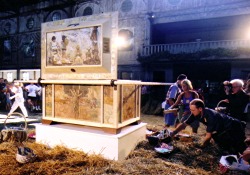| |||
|
View the source of this article at http://www.uvm.edu/theview/article.php?id=1814 the view, University of Vermont Cameron Davis ’76 has a lifelong passion for art and the environment. The lecturer of art has long been successful at blending these loves in courses such as “Painting and Issues of Ecological Perception” and “Drawing in the Natural World.” More recently, she’s combined the two in a participatory art project with international scope and resonance. November 7-9, Davis, along with local artist Sally Linder, will speak at the “Earth Charter + 5” in Amsterdam, a multinational conference on the implementation of sustainable development. Representatives from dozens of countries, including Queen Beatrix of the Netherlands, will meet to discuss the impact of the Earth Charter, a United Nations-sponsored declaration of fundamental principles for building a just, sustainable and peaceful global society. Davis and Linder were invited to present their Temenos Project, a multi-faceted art effort that includes The Ark of Hope, a 49- by 32- inch wooden chest designed by Linder to house a copy of the Earth Charter she handwrote on a piece of papyrus harvested at UVM Research Professor John Todd’s Living Systems, Inc., in South Burlington. Also inside the ark are thousands of Temenos Books, 8- by 2-inch books made by artists and school children in Vermont, six other states and dozens of other countries, filled with pages of visual prayers and affirmations based on the Earth Charter’s 16 principles. Since their unveiling at Shelburne Farms in September of 2001 at “For Love of Earth, A Celebration of the Earth Charter,” a 2,000-person Temenos event organized by Davis, Linder, students and faculty, the ark and Temenos books have traveled around the world. They were exhibited at a U.N. summit; the International Women’s Conference in India; and the World Summit on Sustainable Development in Johannesburg, South Africa. When the exhibit is not traveling it is on exhibit at the Interfaith Center of New York. “This is a grassroots project that organically grew out of the inspiration of the charter itself,” says Davis. “It started with us asking ourselves what we could do as artists about the state of the world. The Earth Charter is very abstract, kind of like reading the Constitution. We wanted to embody it and bring it to life. Art is a great tool for stirring the soul and moving people into action.” Rippling Circles The creation of the Temenos Project is a story of art, love and perseverance. Its seeds were sown in 1999 when Davis, Linder and a small group of fellow artists gathered together to find ways to promote global healing through art, which they believe creates changes in awareness, leading to meaningful action. Establishing a Temenos, a magical sacred circle where special rules apply and extraordinary events occur, each artist made a Temenos Book. Moved by the experience, they started guiding individuals and groups in the creation of the books and “earth masks,” facial masks of animals and other ecological representations made by small children so they could participate in the process. “The response was incredible,” says Linder, who worked with Davis to get 22 Vermont cities and towns to officially endorse the Earth Charter. This early success led to the idea for the For Love of Earth Celebration at Shelburne Farms, which featured keynote speaker Jane Goodall, global peace walker Satish Kumar, musician Paul Winter, and Earth Charter Commission member Steven C. Rockefeller, and the creation of the Ark of Hope, which Linder says came to her “in a vision.” Linder sought out Vermont cabinetmaker Kevin Jenness, who built the ark from a single plank of sycamore maple from a sustainable forest in Germany. The five painted panels that form the sides and top of the ark, which weighs 800 pounds with the Temenos books inside, represent the flora and fauna of the world. Each panel visualizes a season, a direction, an element, and a universal symbol. Symbols of faith from religions and indigenous societies were painted in honor of children and young animals. The 96-inch carrying poles are meant to represent unicorn horns which render evil ineffective. Beth Haggart, university lecturer and local artist, lined the ark with fabric. Moved to action by the attacks of Sept. 11, which occurred two days after the Shelburne Farms event, Linder and a few friends began walking the ark to New York City. Hundreds of supporters joined the two-month walk along the way and added their own prayers and images for global healing to the Temenos books. The journey ended with the ark and Temenos books being exhibited at the United Nations in January and February of 2002. Davis credits much of the success of the project to the efforts of students in her Earth Charter senior seminar in the Environmental Program, which explores the use of art as an activist tool, and “Painting and Issues of Ecological Perception” course. Students helped promote the Shelburne Farms event with slide shows at Radio Bean and other local haunts, and helped facilitate the Temenos Books project in schools and at conferences. Students in Davis’ “Painting, Ecological Perception and Theory” course, including Lisa Shaw, a continuing education student who is presenting with Davis in Amsterdam, volunteered at the event along with a number of environmental program alums. “This is a grassroots project started in Vermont that has inspired people to read the Earth Charter and add art to something that travels around the world,” Davis says. “I think it’s been an incredibly moving experience for everyone involved.” |

Gifting Temenos Books to Ark of Hope |
||
|
|
|||
|
Published: Friday, December 02, 2005.
Story By: Jon Reidel |
|||
| copyright © 2001 - 2009 Ark of Hope |
